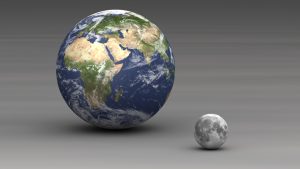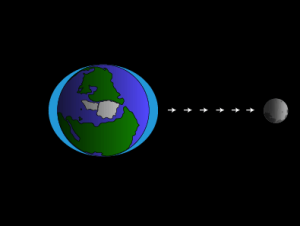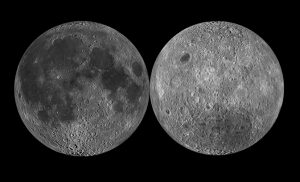Week 3: The Moon
Dr. Ted Neal; Alexis Hatvick; and Claudia Witte
Week 3: The Moon
Formative Assessment: The Moon
🧠 Big Ideas and Big Questions
- What are the phases of the Moon and why do they occur?
- How does the Moon affect life on Earth?
- Why does the moon have two very different looking sides?
What have we learned about the Moon’s surface, structure, and history?
📚 Vocabulary
- Phases of the Moon: The different shapes of the Moon visible from Earth as it orbits our planet.
- Tidal Locking: The phenomenon where the Moon rotates on its axis in the same time it takes to orbit Earth, so the same side always faces us.
- Maria: Large, dark, basaltic plains on the Moon, formed by ancient volcanic eruptions.
- Crater: A bowl-shaped depression caused by the impact of a meteorite or other celestial body.
🧪 Examples
Everyone on Earth sees the same phase on the same night. The cycle from new to full and back to new takes about 29.5 days.
Phases of the Moon
The Moon orbits Earth once every 28 days. Depending on its position relative to the Earth and the sun, we see different phases:
The phases of the moon are:
- New: The Moon’s face is not visible from Earth
- Crescent: Between a new moon and a quarter moon
- Quarter: From Earth, we can see half of the moon’s face, which is a quarter of the entire moon
- Gibbous: Between a quarter moon and a full moon
- Full: All of the Moon’s face is visible from Earth
For the first half of this cycle, the visible part of the Moon waxes or grows larger from a new moon to a full moon. After reaching a full moon, the Moon wanes or grows smaller back to a new moon for the second half of the cycle.
The image below shows the Moon’s phases.

Where are the Moon, Sun, and Earth in relation to each other for the different Moon phases?
For further explanation of the Moon’s phases, watch the following video.
Video credit: “The Moon” by Khan Academy is licensed under CC BY-NC-SA 3.0. Note: All Khan Academy content is available for free at khanacademy.org.
The Moon’s Surface and Features
- The Moon’s surface is covered in regolith, a powdery dust and rocky debris created by billions of years of meteorite impacts.
- Maria (singular: mare) are the large, dark plains formed by ancient volcanic activity. Early astronomers thought these were seas.
- The Moon is heavily cratered because it lacks an atmosphere to protect it from impacts and has no weather to erode craters away.
The far side of the Moon (sometimes called the “dark side”) is not visible from Earth due to tidal locking. It is more rugged and has fewer maria than the near side.
The Moon’s Structure
- Core: Small, partially molten iron core.
- Mantle: Thick layer of silicate rock.
- Crust: Outer layer, thinner on the near side than the far side.
The Moon’s Influence on Earth
- The Moon’s gravity causes tides in Earth’s oceans. As Earth rotates, the gravitational pull of the Moon causes water to bulge out on the side closest to the Moon and the side farthest from the Moon, creating high tides.
- The Moon stabilizes Earth’s axial tilt, which helps regulate our climate and seasons.
The Moon’s Origin:
Where did the moon come from? Scientists believe that the early earth, while molten prior to cooling down, was struck by a protoplanet named Theia. This impact caused the tilt of the earth, causing seasons, plus gave us a moon. Scientists now believe this was a direct hit but that is still under investigation. This is evident in the decreased gravity, due to a lack of heavy elements that are found in our core, due to a lower density of material on the moon. You may know you weigh 1/6th the amount on the moon, directly related to the mass makeup of the moon. That, however, is NOT a diet plan, you’ll still have the same Mass (LOL). Here is a video on how science thinks the moon was created:
Scientists believe the Moon formed about 4.5 billion years ago when a Mars-sized object (Theia) collided with the early Earth. The debris from this impact coalesced to form the Moon. Evidence for this includes the similar composition of Earth and Moon rocks, and the Moon’s relatively small iron core.
The Moon in Human Culture
- The Moon has inspired myths, calendars, and art in cultures around the world.
- Lunar eclipses, when Earth’s shadow falls on the Moon, have been observed and recorded for millennia.
Characteristics of the Moon
- Distance from Earth: 239,000 miles
- Size: As seen in the image, below, he moon is 1/4 of the earth’s diameter, but only 1/50 of the earth’s volume. This can be confusing to students who think it is 1/4 of the volume but it is really a 1/4 of the diameter. When pictured in three-dimensions, this equates to the Earth is 50 times larger than the Moon. That means, you could fit 50 moons inside of the earth.

Own work is licensed under CC BY-SA 3.0.
- Composition:
- Very similar to Earth
- Has an iron core, mantle, and crust
- Surface: The Moon’s rocky surface is covered in dormant volcanoes and craters which are the results of impacts from meteorites and asteroids over billions of years. The Moon is covered with craters for two reasons:
- It does not have an atmosphere to protect it from the impact of objects such as asteroids in space.
- There is no wind on the Moon to erode existing craters.
- Climate: The Moon has no atmosphere, wind, or weather. Thus, the temperature can range from extremely hot to extremely cold since there is no atmosphere to protect it from the Sun’s heat or insulate the surface.
- Gravity: Remember, more mass=more gravity and less mass=less gravity. As such, the Moon has 1/6 of the gravity of Earth. This means if you weigh 60 lbs on Earth, you would weigh 10 lbs on the Moon.
- The Moon’s gravity, although weaker than Earth’s gravity, has enough pull to move water. This is what causes tides on Earth. As Earth rotates on its axis, the area on the near side of the Moon feels its gravity. As seen in the image below, this causes the water on that side–as well as the opposite side of Earth–to bulge out and create a high tide. As Earth continues to rotate, the gravitational pull weakens and the water recedes, creating a low tide. Since Earth completes one full rotation on its axis each day, most areas have two high tides and two low tides per day.

Sides of the Moon
There are two sides of the moon: the near side (the side we can see from Earth) and the far side (also known as the dark side). The Moon does not create its own light; it gets light from the Sun. As such, the dark side is not actually dark–it is just called the dark side because we cannot see it from Earth.

Since Earth has a larger mass, it exerts a stronger gravitational pull on the Moon. Earth’s pull controls the Moon’s orbit so that the Moon rotates once on its axis in the same amount of time it takes to orbit Earth. Therefore, the same side of the Moon is always facing Earth and we have a near side and a dark side. This effect is called tidal locking.
Click this link to see an animation of how tidal locking works as the Moon orbits Earth.
Now, why do we have two different looking sides to the moon? That is a realm of emerging science. The dark side, the side we don’t see, was first seen in 1959 due to the Russian Space Agency taking photographs. This revealed a very different make up of the other side of the moon. The darker areas, known as Maria, are lava fields. This is due to volcanic activity but that isn’t the whole story. The near side remained 200 degrees hotter than the dark side of the moon. This could have been caused by residual heat due to constantly facing the early molten earth. This cooling difference is a likely cause of having the near side of the moon to have a crustal thickness of between 6 and 10 km. The darkside has a crustal thickness closer to 60 km. The difference means that the dark side crust is much thicker, meaning meteors couldn’t reach the mantle or that volcanoes couldn’t reach the surface as easily. However, this science is still under investigation as there are many theories.
| Nearside of the Moon | Farside of the Moon |
|
|
|
|
|
|
👩🏫 Teacher Talk
- This lesson aligns with NGSS 1-ESS1-1: Use observations of the sun, moon, and stars to describe patterns that can be predicted.
- NGSS 5-ESS1-2: Represent data in graphical displays to reveal patterns of lunar phases and eclipses.
- Encourage students to keep a Moon journal and discuss how the Moon’s phases relate to the calendar.
📎 Resources
- https://www.flickr.com/photos/pkmonaghan/6485703751
- https://www.youtube.com/watch?v=ZQcf9xLABa0
- https://moon.nasa.gov/
- https://spaceplace.nasa.gov/moon/en/
💭 Reflections and Additional Resources
- Observe the Moon for several nights. How does its appearance change?
- Watch the video on moon phases: The Moon (Khan Academy)
- Explore: Images of Moon Phases
- Try: Keep a Moon journal and sketch its phases.
Next Generation Science Standards: NGSS
Performance Expectations
| 1-ESS1-1. | Use observations of the sun, moon, and stars to describe patterns that can be predicted. [Clarification Statement: Examples of patterns could include that the sun and moon appear to rise in one part of the sky, move across the sky, and set; and stars other than our sun are visible at night but not during the day.] [Assessment Boundary: Assessment of star patterns is limited to stars being seen at night and not during the day.] |
|---|
| MS-ESS1-1. | Develop and use a model of the Earth-sun-moon system to describe the cyclic patterns of lunar phases, eclipses of the sun and moon, and seasons. [Clarification Statement: Examples of models can be physical, graphical, or conceptual.] |
|---|
First Grade
K-6 Standards
1-ESS1-1. Use observations of the sun, moon, and stars to describe patterns that can be
predicted.
ESS1.A: The Universe and its Stars
Fifth Grade
ESS1.B: Earth and the Solar System
Middle School
ESS1.A: The Universe and Its Stars
ESS1.B: Earth and the Solar System
- The solar system consists of the sun and a collection of objects, including planets, their moons, and asteroids that are held in orbit around the sun by its gravitational pull on them. (MS-ESS1-2),(MS-ESS1-3)
- This model of the solar system can explain eclipses of the sun and the moon. Earth’s spin axis is fixed in direction over the short-term but tilted relative to its orbit around the sun. The seasons are a result of that tilt and are caused by the differential intensity of sunlight on different areas of Earth across the year. (MS-ESS1-1)
Crosscutting Concepts
Patterns
– – – – – – – – – – – – – – – – – – – – – – – – – – – – – – – – – – – –
Connections to Nature of Science
Scientific Knowledge Assumes an Order and Consistency in Natural Systems
- Science assumes natural events happen today as they happened in the past. (1-ESS1-1)
- Many events are repeated. (1-ESS1-1)
Lesson ideas:
Take children outside to see the Moon in the daytime. Show them how to observe the Moon, and keep a Moon journal, and encoruage them to look for the Moon day and night. Look at your Moon journal to see what the patterns are.
Try to recreate what they see outside with the Earth Sun Moon system.

